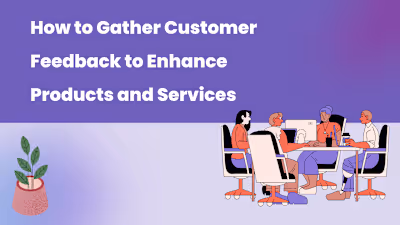Post-Onboarding Customer Nurturing Strategy For CS Teams
Most SaaS businesses think the work stops at acquiring customers. Sorry to burst your bubbles, but customer acquisition is just the beginning. The real work starts during post-onboarding—this is where lots of SaaS businesses fall short.
Users without post-onboarding support may struggle with advanced features, causing frustration and reduced productivity.
And this results in customer churn.
The customer success team plays an important role in ensuring a positive customer experience. They provide proactive engagement and a personalized post-onboarding strategy. By doing so, they not only guide customers through their journey but also build lasting relationships based on trust and support.
This article will explore customer success teams approaches to fostering post-onboarding strategies to guarantee customer success.
Understanding the Customer Journey
Nurturing a customer post-onboarding involves understanding their journey.
The customer journey is a step-by-step, seamless interaction from initial brand awareness to post-purchase engagements.
A vital aspect of the customer journey involves implementing an onboarding process.
Establishing an Onboarding Process
An onboarding process is a structured approach to introduce new clients to a product or service seamlessly. It includes a step-by-step tutorial on essential features, a welcome email series, and in-app guidance.
The Harvard Business Review stated that a seamless onboarding experience increases customer retention by 50%.
A structured onboarding process minimizes the learning curve, preventing user overwhelm and reducing churn rates. Companies must actively listen to user feedback, understand needs, and adapt onboarding processes to address challenges. Neglecting this aspect can impact long-term customer satisfaction.
The Benefits of Tracking and Analyzing the Customer Journey
Tracking and analyzing the customer journey offers substantial benefits. It optimizes customer success by identifying onboarding inefficiencies and lessening support burdens. Mapping customer touchpoints in each journey stage enables personalized communication, fosters feature adoption and tracks user satisfaction.
Good to know: Analytics tools like Google Analytics, Mixpanel, and Hotjar provide deep insights, and prevent churn by adapting to evolving customer needs.
Identifying Potential Challenges Along the Way
Identifying potential challenges post-onboarding involves a comprehensive analysis of customer feedback from various sources. Monitoring how users behave, tracking their engagement, and combining that with usability testing and internal feedback help spot when people are losing interest or facing difficulties. A proactive approach to addressing these challenges enhances the overall customer experience, ensuring sustained success.
Developing a Strategy for Nurturing Customers After Onboarding
In this section, we’d be looking at how to develop a post-onboarding strategy for customer nurturing:
Setting Goals and Expectations for Customer Success
To develop a strategy for post-onboarding customer nurturing, the first step involves establishing specific, measurable, achievable, relevant, and time-bound (SMART) goals.
These goals guide the customer journey, offering users a clear path forward and a defined sense of anticipated value. Without such clarity, the risk of communication gaps, trust erosion, and missed growth opportunities looms.
Defining specific outcomes, quantifying goals with key performance indicators (KPIs), and effectively communicating expectations are essential for aligning customer success teams with broader business objectives.
The strategic, goal-oriented approach provides a structured roadmap for the post-onboarding phase and ensures a purposeful and focused strategy, laying the foundation for nurturing enduring customer relationships.
Assessing Customer Needs Post-Onboarding
One major mistake many SaaS companies make during post-onboarding is prioritizing new features over user needs, which can lead to confusion and frustration. To avoid this, customer success teams should examine users' requirements after onboarding and tailor strategies to evolving needs.
Ongoing assessment, especially after the initial phase, ensures continuous satisfaction and long-term success.
Use surveys, feedback mechanisms, and direct communication through customer success managers to gather insights into user behavior and preferences. And revisit customer needs to adapt strategies, ensuring continuous satisfaction and long-term success.
Creating a Personalized Experience for Each Customer
Also, customer success teams must use personalization to nurture customers post-onboarding. Personalization in SaaS helps you enhance engagement, generate more leads, convert detractors into promoters, and improve customer retention. SaaS businesses will fail to connect with customers and demonstrate their product’s unique value without personalization, and user engagement will suffer.
Businesses should tailor the website interface and user experience based on user preferences, behavior, or previous interactions to maximize personalization.
For example, a website may dynamically display content, suggest products, or adjust the layout to align with the user's historical preferences, creating a more personalized and engaging experience.
Also, implementing personalized rewards further solidifies the bond between the customer and the brand. Notably, McKinsey highlights a substantial 5–15% increase in revenue for companies that embrace and implement personalized customer experiences.
Taking Advantage of Automation Tools to Streamline Communication and Support Processes
A complementary approach to nurturing customers after onboarding involves SaaS companies optimizing communication and support using automation tools. These tools manage tasks with minimal human intervention, weaving personalized user experiences into a seamless and efficient customer engagement strategy.
For instance, using help desk software like Zendesk, companies can automate ticket routing and response, ensuring prompt and accurate customer support. Chatbots powered by tools like HubSpot can provide instant assistance and gather relevant information to address customer inquiries.
Utilizing Data Insights to Improve Engagement and Retention Rates
Furthermore, after onboarding, SaaS companies can leverage data insights to enhance customer engagement and retention rates. By analyzing user behavior, preferences, and usage patterns, they can identify opportunities to improve the customer experience.
For example, if data shows that customers are not using certain features, the company can proactively reach out with personalized recommendations and tutorials to encourage adoption.
Data insights can also help identify potential churn indicators, allowing the customer success team to intervene with targeted retention strategies.
Establishing Clear Channels For Feedback and Communication
Establishing clear channels for feedback and communication is also vital to nurturing customers after onboarding. SaaS businesses can provide multiple avenues for customers to share their thoughts, suggestions, and concerns. It can include email, chat support, community forums, or dedicated feedback portals.
By actively listening to customer feedback, promptly addressing issues, and implementing requested enhancements, the company demonstrates its commitment to customer satisfaction and cultivates a sense of partnership with the customer.
Measuring the Effectiveness of Your Nurture Strategy
Establish metrics that align with business goals to measure the effectiveness of your post-onboarding nurture strategy. These metrics ensure tracking customer retention churn rate, evaluating potential upsells and cross-sells, and assessing customer satisfaction (CSAT) through feedback surveys and the Net Promoter Score (NPS).
Monitor the churn rate for insights into customer engagement and satisfaction, striving for a low rate by consistently delivering value and addressing needs. At the same time, increase expansion revenue by upselling and cross-selling.
For instance, a project management SaaS can upgrade users with advanced feature needs. Also, implement cross-selling by suggesting complementary products; e.g., a smartphone purchase prompts recommendations for accessories, enhancing the overall experience.
Measure success through surveys, analyzing correlations between high CSAT scores and activities. Identifying the elements contributing to high CSAT and NPS scores allows for continuous refining and optimization of your post-onboarding nurture strategy. Also, assessing NPS provides a comprehensive view of the strategy's influence on perception and loyalty.
Conclusion and the long-term benefits of a well-executed customer nurturing strategy
The Customer Success Team ensures long-term success in the SaaS industry through well-executed customer nurturing strategies. Companies can foster lasting customer relationships by understanding and addressing post-onboarding challenges through personalized experiences, automation tools, and clear communication channels.
Ready to elevate your customer success game? Implement these insights and watch your SaaS business thrive.
Like this project
Posted Jun 2, 2024
This guide explains how Customer Success Team nurtures customers after onboarding by understanding their journey, setting goals, and assessing needs.
Likes
0
Views
11





